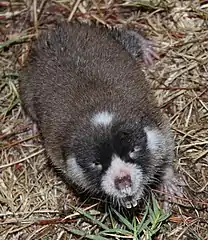| Georychus | |||
| Illiger, 1811[1] | |||
 Przedstawiciel rodzaju – piaskogrzeb przylądkowy (G. capensis) | |||
| Systematyka | |||
| Domena | |||
|---|---|---|---|
| Królestwo | |||
| Typ | |||
| Podtyp | |||
| Gromada | |||
| Podgromada | |||
| Rząd | |||
| Podrząd | |||
| Infrarząd | |||
| (bez rangi) | incertae sedis[2] | ||
| Rodzina | |||
| Rodzaj |
piaskogrzeb | ||
| Typ nomenklatoryczny | |||
|
Mus capensis Pallas, 1778 | |||
| Synonimy | |||
|
| |||
| Gatunki | |||
| |||
Piaskogrzeb[7] (Georychus) – rodzaj ssaka z rodziny kretoszczurowatych (Bathyergidae).
Zasięg występowania
Rodzaj obejmuje jeden żyjący współcześnie gatunek występujący w południowej Afryce[2][8].
Morfologia
Długość ciała (bez ogona) 85–231,6 mm, długość ogona 17,3–23,7 mm; masa ciała 87,7–272,3 g[9][10].
Systematyka
Rodzaj zdefiniował w 1811 roku niemiecki zoolog Johann Karl Wilhelm Illiger w książce swojego autorstwa o tytule Prodromus systematis mammalium et avium[1]. Illiger wymienił trzy gatunki – Mus aspalax Pallas, 1776, Mus talpinus Pallas, 1770 oraz Mus capensis Pallas, 1779 – z których gatunkiem typowym jest piaskogrzeb przylądkowy (G. capensis).
Etymologia
- Georychus (Georrychus, Georhychus, Georynchus): gr. γεωρυχος geōrukhos ‘kopiący ziemię’, od γεω- geō- ‘ziemny-’, od γη gē ‘ziemia’; ορυσσω orussō ‘kopać’[11].
- Fossor: łac. fossor ‘kopacz, grabarz’, od fodo ‘kopać’[12]. Gatunek typowy: Fossor leucops H. Lichtenstein, 1844 (= Mus capensis Pallas, 1778).
Podział systematyczny
Badania genetyczne z 2018 roku sugerują, że Georychus może zawierać aż pięć gatunków[13]. Do rodzaju należy jeden występujący współcześnie gatunek[14][10][2][7]:
- Georychus capensis (Pallas, 1778) – piaskogrzeb przylądkowy
Opisano również gatunek wymarły z plejstocenu dzisiejszej Południowej Afryki[15]:
- Georychus robertsi (Broom, 1937)
Uwagi
Przypisy
- 1 2 J.K.W. Illiger: Prodromus systematis mammalium et avium: additis terminis zoographicis utriusque classis, eorumque versione germanica. Berolini: Sumptibus C. Salfeld, 1811, s. 87. (łac.).
- 1 2 3 C.J. Burgin, D.E. Wilson, R.A. Mittermeier, A.B. Rylands, T.E. Lacher & W. Sechrest: Illustrated Checklist of the Mammals of the World. Cz. 1: Monotremata to Rodentia. Barcelona: Lynx Edicions, 2020, s. 367–368. ISBN 978-84-16728-34-3. (ang.).
- ↑ J. Minding: Ueber die geographische Vertheilung der Säugethiere. Berlin: Enslin, 1829, s. 80. (niem.).
- ↑ J.A. Wagner: Supplementband. W: J.Ch.D. von Schreber: Die Säugthiere in Abbildungen nach der Natur, mit Beschreibungen. Cz. 3: Die Beutelthiere und Nager (erster Abschnitt). Erlangen: Expedition des Schreber’schen säugthier- und des Esper’schen Schmetterlingswerkes, 1843, s. 369. (niem.).
- ↑ J.R. Forster & M.C.H. Lichtenstein: Descriptiones animalium quae in itinere ad Maris Australis terras per annos 1772, 1773 et 1774 suscepto. Berolini: Ex Officina Academica, 1844, s. 31–32. (łac.).
- ↑ S.M. Jackson, J.J. Jansen, G. Baglione & C. Callou. Mammals collected and illustrated by the Baudin Expedition to Australia and Timor (1800-1804): A review of the current taxonomy of specimens in the Muséum national d’Histoire naturelle de Paris and the illustrations in the Muséum d'Histoire naturelle du Havre. „Zoosystema”. 43 (21), s. 424, 2021. DOI: 10.5252/zoosystema2021v43a21. (ang.).
- 1 2 Nazwy zwyczajowe za: W. Cichocki, A. Ważna, J. Cichocki, E. Rajska-Jurgiel, A. Jasiński & W. Bogdanowicz: Polskie nazewnictwo ssaków świata. Warszawa: Muzeum i Instytut Zoologii PAN, 2015, s. 286. ISBN 978-83-88147-15-9. (pol. • ang.).
- ↑ D.E. Wilson & D.M. Reeder (redaktorzy): Genus Georychus. [w:] Mammal Species of the World. A Taxonomic and Geographic Reference (Wyd. 3) [on-line]. Johns Hopkins University Press, 2005. [dostęp 2021-11-16].
- ↑ R. Honeycutt: Family Bathyergidae (African Mole-rats). W: D.E. Wilson, T.E. Lacher, Jr & R.A. Mittermeier (redaktorzy): Handbook of the Mammals of the World. Cz. 6: Lagomorphs and Rodents I. Barcelona: Lynx Edicions, 2016, s. 367–368. ISBN 978-84-941892-3-4. (ang.).
- 1 2 Class Mammalia. W: Lynx Nature Books: All the Mammals of the World. Barcelona: Lynx Edicions, 2023. ISBN 978-84-16728-66-4. (ang.).
- ↑ Palmer 1904 ↓, s. 293.
- ↑ Palmer 1904 ↓, s. 286.
- ↑ J.H. Visser, N.C. Bennett & B. Jansen van Vuuren. Spatial genetic diversity in the Cape mole-rat, Georychus capensis: Extreme isolation of populations in a subterranean environment. „PLoS ONE”. 13 (3), s. e0194165, 2018. DOI: 10.1371/journal.pone.0194165. (ang.).
- ↑ N. Upham, C. Burgin, J. Widness, M. Becker, C. Parker, S. Liphardt, I. Rochon & D. Huckaby: Treeview of Mammalian Taxonomy Hierarchy. [w:] ASM Mammal Diversity Database (Version 1.11) [on-line]. American Society of Mammalogists. [dostęp 2023-10-15]. (ang.).
- ↑ R. Broom. On some new Pleistocene mammals from limestone caves of the Transvaal. „South African Journal of Science”. 33, s. 760, 1937. (ang.).
Bibliografia
- T.S. Palmer. Index Generum Mammalium: a List of the Genera and Families of Mammals. „North American Fauna”. 23, s. 1–984, 1904. (ang.).